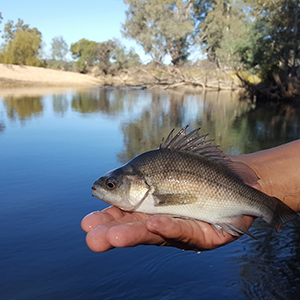Larval fish sensitivity to a simulated cold-water pulse varies between species and age

Accepted: 27 June 2022
Supplementary: 167
HTML: 135
All claims expressed in this article are solely those of the authors and do not necessarily represent those of their affiliated organizations, or those of the publisher, the editors and the reviewers. Any product that may be evaluated in this article or claim that may be made by its manufacturer is not guaranteed or endorsed by the publisher.
Authors
The release of cold-water from hypolimnetic zones of impoundments sharply reduces downstream riverine water temperature. This cold-water pollution (CWP) can extend for hundreds of kilometres, severely challenging the physiological ability of aquatic fauna, particularly ectotherms such as fish, to maintain essential processes such as metabolism, development and growth and survival. The impact of CWP on native fish, especially early life stages, is poorly known. We investigated the effect of a 24-hour exposure to a range of environmentally-related water temperatures (8, 10, 12, 14, 16, 18 and 20°C) on three age-classes (<24-hour-old, 7-day and 14-day-old larvae) of two Australian native fish species: Murray cod (Maccullochella peelii) and Macquarie perch (Macquaria australasica). Overall, larvae of M. peelii were more sensitive to lower water temperatures and hence CWP than M. australasica, indicated by higher rates of equilibrium loss. Larvae of M. peelii were most sensitive to exposure at seven days old whereas M. australasica larvae were most sensitive at <24-h-old. Using our results, we modelled pre- and post-impoundment temperature scenarios and estimated the downstream CWP footprint for both species in an Australian river reach. Larvae of M. peelii were predicted to be absent from the first 26 km of river downstream of the impoundment compared with no impact on the distribution of M. australasica. Managing riverine water temperature below impoundments is fundamental to promoting positive outcomes for endemic fish on not only a local, but global basis. This study emphasises the differential impact of CWP among the critical early life stages and fish species and highlights the urgent need to better manage hypolimnetic water releases to improve downstream river ecosystems.
Edited by
Pietro Volta, CNR-IRSA Verbania, ItalyHow to Cite

This work is licensed under a Creative Commons Attribution-NonCommercial 4.0 International License.
Similar Articles
- Valeria LENCIONI, Deborah BOSCHINI, Lorena REBECCHI, Expression of the 70 kDa Heat shock protein family in Alpine freshwater chironomids (Diptera, Chironomidae) under natural conditions , Journal of Limnology: Vol. 68 No. 2 (2009)
- Aldo MARCHETTO, Bachisio M. PADEDDA, Maria A. MARIANI, Antonella LUGLIÈ, Nicola SECHI, A numerical index for evaluating phytoplankton response to changes in nutrient levels in deep mediterranean reservoirs , Journal of Limnology: Vol. 68 No. 1 (2009)
- Ranielle Daiana dos Santos Silva, Juliana Santos Severiano, Dayany Aguiar de Oliveira, Camila Ferreira Mendes, Vanessa Virgínia Barbosa, Mathias Ahii Chia, José Etham de Lucena Barbosa, Spatio-temporal variation of cyanobacteria and cyanotoxins in public supply reservoirs of the semi-arid region of Brazil , Journal of Limnology: Vol. 79 No. 1 (2020)
- Rachel C. HELLIWELL, Martin KERNAN, Modelling hydrochemical and ecological trends in acid sensitive surface waters in the Scottish Highlands , Journal of Limnology: Vol. 63 No. 1 (2004)
- Tanner Liang, Julian Aherne, Physical and chemical characteristics of 1300 lakes and ponds across the Canadian Arctic , Journal of Limnology: Vol. 79 No. 3 (2020)
- Mirosław ŚLUSARCZYK, Environmental plasticity of fish avoidance diapause response in Daphnia magna , Journal of Limnology: Vol. 63 No. s1 (2004): Diapause In Aquatic Invertebrates
- Łukasz Michalczyk, Łukasz Kaczmarek, The Tardigrada Register: a comprehensive online data repository for tardigrade taxonomy , Journal of Limnology: Vol. 72 No. s1 (2013): 12th International Symposium on Tardigrada
- Franco Tassi, Jacopo Cabassi, Cesar Andrade, Cristiana Callieri, Catarina Silva, Fatima Viveiros, Gianluca Corno, Orlando Vaselli, Enrico Selmo, Andrea Gallorini, Andrea Ricci, Luciano Giannini, Josè V. Cruz, Mechanisms regulating CO2 and CH4 dynamics in the Azorean volcanic lakes (São Miguel Island, Portugal) , Journal of Limnology: Vol. 77 No. 3 (2018)
- BRUNO PETRICCIONE, ROSARIO MOSELLO, ALDO MARCHETTO, PREFACE , Journal of Limnology: Vol. 61 No. s1 (2002): National Programme for Forest Ecosystems Control CONECOFOR
- André F. LOTTER, Wolfgang HOFMANN, Christian KAMENIK, Andrea LAMI, Christian OHLENDORF, Michael STURM, Willem O. VAN DER KNAAP, Jacqueline F.N. VAN LEEUWEN, Sedimentological and biostratigraphical analyses of short sediment cores from Hagelseewli (2339 m a.s.l.) in the Swiss Alps , Journal of Limnology: Vol. 59 No. s1 (2000): Climatic variability and ecosystem dynamics at remote mountain lakes
<< < 65 66 67 68 69 70 71 72 73 74 > >>
You may also start an advanced similarity search for this article.
-
John D. Koehn, Charles R. Todd, Henry Wootton, Michael JoyMarine and Freshwater Research : 2023

 https://doi.org/10.4081/jlimnol.2022.2056
https://doi.org/10.4081/jlimnol.2022.2056





